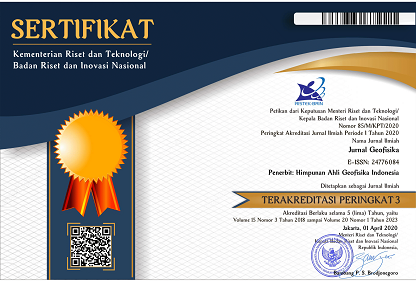Analisis Gempabumi Lombok 2018 Berdasarkan Mekanisme Sumber, Distribusi Slip, Asperity, dan Perubahan Nilai (Coulomb Stress) Pada Bidang Sesar
Keywords
slip, asperity, Coulombstress, gempabumiAbstract
Gempabumi signifikan yang terjadi di Lombok pada bulan Juli hingga Agustus 2018 dengan magnitudo yang berkisar antara M 5,8 hingga 7,0. Pada periode tersebut terjadi kejadian gempabumi yang terjadi secara berurutan yaitu Mw 6,5 tanggal 28 Juli 2018 (22:47:38 UTC), Mw 6,9 tanggal 5 Agustus 2018 (11:46:38 UTC), Mw 5,9 tanggal 9 Agustus 2018 (05:25:31 UTC), Mw 6,4 tanggal 19 Agustus 2018 (04:10:22 UTC) dan Mw 6,9 tanggal 19 Agustus 2018 (14:56:28 UTC). Fenomena tersebut sangat jarang terjadi karena gempabumi memerlukan waktu yang relatif lama untuk mengakumulasi energi sebelum dilepaskan. Berdasarkan keunikan tersebut, pemodelan slip di bidang sesar untuk mengetahui sebaran zona akumulasi energi yang direpresentasikan oleh asperity dengan menginversi gelombang body dari stasiun teleseismik pada frekuensi rendah. Hasil pemodelan slip ini dikonfirmasi oleh sebaran perubahan nilai Coulomb stress setelah gempa. Hasilnya menunjukkan bahwa zona asperity gempabumi Lombok berada pada bagian up-dip. Distribusi slip dominan mengarah hampir tegak lurus ke arah utara. Pada gempabumi Mw 6,4 tanggal 19 Agustus 2018, arah vektor slip mengarah ke gempabumi Mw 6,9 tanggal 19 Agustus 2018, hal tersebut mengindikasikan bahwa gempabumi Lombok sebenarnya saling memicu satu dengan lainnya. Hasil pemodelan juga menunjukkan bahwa gempabumi signifikan di Lombok tidak memiliki asperity tunggal, namun terdistribusi pada bidang sesar di dekat permukaan. Berdasarkan hasil penelitian ini, kami menduga bahwa wilayah utara pulau Lombok mengalami pelemahan batuan karena tidak mampu lagi menahan akumulasi energi sehingga gempabumi Lombok saling memicu. Berdasarkan perubahan nilai Coulomb stress dapat disimpulkan bahwa gempabumi Mw 6,9 tanggal 5 Agustus 2018 berada di zona peningkatan stress dari gempabumi Mw 6,5 tanggal 28 Juli
2018
References
Cocco, M., Rice, J.R., 2002. Pore pressure and poroelasticity effects in Coulomb stress analysis of earthquake interactions. J. Geophys. Res. Solid Earth 107, ESE-2.
Ibrahim, G., Subardjo, Senjaya, P., 2010. Tektonik dan Mineral di Indonesia. Jakarta, Puslitbang BMKG.
Ide, S., 2015. 4.09-slip inversion. Treatise Geophys. 2nd edn. Elsevier, Oxford 215–241.
Kikuchi, M., Kanamori, H., 1991. Inversion of complex body waves—III. Bull. Seismol. Soc. Am. 81, 2335–2350.
Kikuchi, M., Kanamori, H., 2003. Note on Teleseismic Body-Wave Inversion Program, 2003.
Kikuchi, M., Nakamura, M., Yoshikawa, K., 2003. Source rupture processes of the 1944 Tonankai earthquake and the 1945 Mikawa earthquake derived from low-gain seismograms. Earth, Planets Sp. 55, 159–172.
Kilb, D., Gomberg, J., Bodin, P., 2002. Aftershock triggering by complete Coulomb stress changes. J. Geophys. Res. Solid Earth 107, ESE-2.
King, G.C.P., Stein, R.S., Lin, J., 1994. Static stress changes and the triggering of earthquakes. Bull. Seismol. Soc. Am. 84, 935–953.
Krantz, R.W., 1991. Measurements of friction coefficients and cohesion for faulting and fault reactivation in laboratory models using sand and sand mixtures. Tectonophysics 188, 203–207.
Lay, T., Kanamori, H., 1981. An asperity model of large earthquake sequences.
Mangga, A., n.d. Dkk, 1994. Peta Geol. Lembar Lombok, Nusatenggara Barat, Lap. terbuka Puslitbang.
Murotani, S., Satake, K., Fujii, Y., 2013. Scaling relations of seismic moment, rupture area, average slip, and asperity size for M~ 9 subduction‐zone earthquakes. Geophys. Res. Lett. 40, 5070–5074.
Sokos, E., Zahradník, J., Gallovič, F., Serpetsidaki, A., Plicka, V., Kiratzi, A., 2016. Asperity break after 12 years: the Mw6. 4 2015 Lefkada (Greece) earthquake. Geophys. Res. Lett. 43, 6137–6145.
Stein, R.S., King, G.C.P., Lin, J., 1994. Stress triggering of the 1994 M= 6.7 Northridge, California, earthquake by its predecessors. Science (80-. ). 265, 1432–1435.
Sumy, D.F., Cochran, E.S., Keranen, K.M., Wei, M., Abers, G.A., 2014. Observations of static Coulomb stress triggering of the November 2011 M5. 7 Oklahoma earthquake sequence. J. Geophys. Res. Solid Earth 119, 1904–1923.
Woessner, J., Jonsson, S., Sudhaus, H., Baumann, C., 2012. Reliability of Coulomb stress changes inferred from correlated uncertainties of finite‐fault source models. J. Geophys. Res. Solid Earth 117.
Yagi, Y., Mikumo, T., Pacheco, J., Reyes, G., 2004. Source rupture process of the Tecomán, Colima, Mexico earthquake of 22 January 2003, determined by joint inversion of teleseismic body-wave and near-source data. Bull. Seismol. Soc. Am. 94, 1795–1807.
Yamanaka, Y., Kikuchi, M., 2004. Asperity map along the subduction zone in northeastern Japan inferred from regional seismic data. J. Geophys. Res. Solid Earth 109.
Yamanaka, Y., Kikuchi, M., 2003. Source process of the recurrent Tokachi-oki earthquake on September 26, 2003, inferred from teleseismic body waves. Earth, Planets Sp. 55, e21–e24.
Zubaidah, T., Korte, M., Mandea, M., Hamoudi, M., 2014. New insights into regional tectonics of the Sunda–Banda Arcs region from integrated magnetic and gravity modelling. J. Asian Earth Sci. 80, 172–184.

This work is licensed under a Creative Commons Attribution 4.0 International License.
The copyright of all articles belongs to the authors. All other copyrights is held by the Journal











